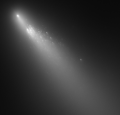73P/Schwassmann–Wachmann
 Disrupted comet Schwassmann–Wachmann 3 (as seen from Mt Laguna on April 19, 2006) | |
| Discovery | |
|---|---|
| Discovered by | Arnold Schwassmann Arno Arthur Wachmann |
| Discovery date | May 2, 1930 |
| Alternative designations | 1930 VI; 1979 VIII; 1990 VIII; 1994w |
| Orbital characteristics A | |
| Epoch | 2017-Feb-16 (JD 2457800.5) |
| Aphelion | 5.2107 AU |
| Perihelion | 0.9721 AU |
| Semi-major axis | 3.091 AU |
| Eccentricity | 0.6855 |
| Orbital period | 5.44 yr |
| Inclination | 11.237° |
| Earth MOID | 0.014 AU (2,100,000 km)[5] |
| Last perihelion | March 16, 2017[1] October 16, 2011[2][3] June 6, 2006[2] |
| Next perihelion | 2022-Aug-25[4] |
73P/Schwassmann–Wachmann, also known as Schwassmann–Wachmann 3, is a periodic comet in the Solar System that is in the process of disintegrating. Starting the 2011 perihelion passage the primary component 73P-C was recovered on 28 November 2010 near apparent magnitude 21.3;[6] it came to perihelion (closest approach to the Sun) on 16 October 2011.[3]
Comet Schwassmann–Wachmann 3 was one of the comets discovered by astronomers Arnold Schwassmann and Arno Arthur Wachmann, working at the Hamburg Observatory in Bergedorf, Germany. It began disintegrating on its re-entry to the inner Solar System in 1995, in a reaction triggered by the Sun's heating of the comet as it emerged from the colder regions of the outer Solar System.
Comet 73P is a parent body of meteor shower Tau Herculids.
The comet was discovered as astronomers were exposing photographic plates in search of minor planets for a minor planet survey, on May 2, 1930. The comet was lost after its 1930 apparition, but was observed several more times.
73P/Schwassmann–Wachmann has an orbital period of 5.4 years so that it comes nearest to the Earth every 16 years. The primary fragment 73P-C has an Earth-MOID of 0.04 AU (6,000,000 km; 3,700,000 mi).[3] 73P was originally estimated to have a core diameter of 1100 meters.
Breakup[]
In 1995, 73P began to disintegrate.[7] It was seen to break into four large pieces labeled 73P-A, B, C, & D.[8] As of March 2006, at least eight fragments were known: B, C, G, H, J, L, M & N. On April 18, 2006, the Hubble Space Telescope recorded dozens of pieces of fragments B and G.[citation needed] It appears that the comet may eventually disintegrate completely and cease to be observable (as did 3D/Biela in the 19th century), in which case its designation would change from 73P to 73D. In May 2006, it was known to have split into at least 66 separate objects.[5] In April 2006, fragment C was the largest and the presumed principal remnant of the original nucleus.[8]
The fragments were passing the Earth in late April and early May 2006, coming nearest to the Earth around May 12 at a distance of about 11.9 million km (7.4 million miles), a close pass in astronomical terms (0.08 AU) though with no significant threat of comet–Earth collision. In 1930 when it passed the Earth that close, there were meteor showers with as many as 100 meteors per minute. However, analysis by P. A. Wiegert et al.[9] suggested that a recurrence of that spectacle was unlikely.
The comet was to have been visited by the CONTOUR comet nucleus probe on June 18, 2006. Unfortunately, contact with the probe was lost on August 15, 2002 when it fired its Star 30BP solid rocket motor to inject itself into solar orbit.
Image gallery[]
The B, G and R components of 73P, and Tau Coronae Borealis, May 1, 2006.

The C component of 73P, and the Ring Nebula, May 8, 2006.

This image taken by Andrew Catsaitis of components B and C of Comet 73P/Schwassmann–Wachmann 3 as seen together on 31 May 2006.

This image of fragment C passing the Ring Nebula was taken on 7 May 2006 at St. Francis Xavier University in Antigonish, Nova Scotia, Canada.

Component B as seen by the Hubble Space Telescope. Also available as Video clip

Image by the Spitzer Space Telescope

Comet Schwassmann–Wachmann passes in the field of view of the Ring Nebula on 7 May 2006. Photo by Maynard Pittendreigh.
References[]
- ^ Syuichi Nakano (2011-01-07). "73P/Schwassmann-Wachmann 3 - C (NK 2021)". OAA Computing and Minor Planet Sections. Retrieved 2012-02-18.
- ^ Jump up to: a b 73P past, present and future orbital elements
- ^ Jump up to: a b c "JPL Small-Body Database Browser: 73P/Schwassmann–Wachmann 3-C". Jet Propulsion Laboratory. Retrieved 2011-05-05.
2011-02-23 last obs
- ^ "73P/Schwassmann-Wachmann Orbit". Minor Planet Center. Retrieved 2017-04-07.
- ^ Jump up to: a b "JPL Small-Body Database Browser: 73P/Schwassmann–Wachmann (66 objects)". Retrieved 2008-10-25.
2006-05-24 last obs of main body 3-C
- ^ "MPEC 2010-Y12 : OBSERVATIONS AND ORBITS OF COMETS". IAU Minor Planet Center. 2010-12-18. Retrieved 2011-06-26.
- ^ Whitney Clavin (2006-05-10). "Spitzer Telescope Sees Trail of Comet Crumbs". Spitzer Space Telescope at Caltech. Retrieved 2008-10-25.
- ^ Jump up to: a b "Hubble Provides Spectacular Detail of a Comet's Breakup". Hubblesite (News Release Number: STScI-2006-18). 2006-04-27. Retrieved 2008-10-25.
- ^ Monthly Notices of the Royal Astronomical Society, Volume 361, p. 638 The τ Herculid meteor shower and Comet 73P/Schwassmann–Wachmann 3 P. A. Wiegert, P. G. Brown, J. Vaubaillon and H. Schijns
External links[]
- 73P, bt fragment via Virtual Telescope Project
- Orbital simulation from JPL (Java) / Horizons Ephemeris
- Hubble provides spectacular detail of a comet's breakup
- 73P at Kronk's Cometography
- Mini-comets approaching Earth (NASA)
- Sky and Telescope article
- 73P/Schwassmann–Wachmann at ESA/Hubble
- 73P/Schwassmann–Wachmann 3 (2011) aerith.net
- 73P-c Lightcurve (Artyom Novichonok)
- Cometary object articles
- Periodic comets
- Near-Earth comets
- Split comets
- Discoveries by Friedrich Karl Arnold Schwassmann
- Comets in 2011
- Comets in 2017
- Astronomical objects discovered in 1930









